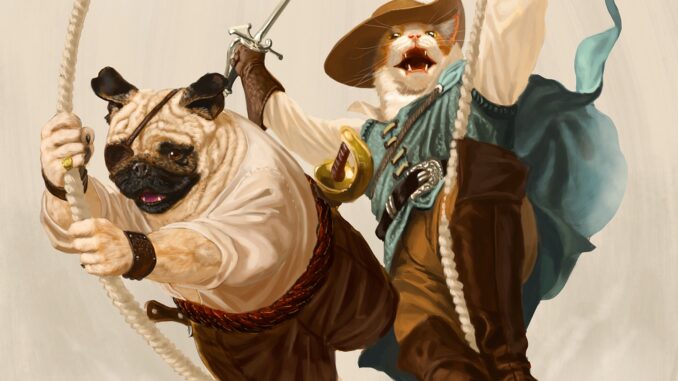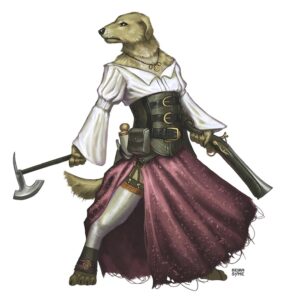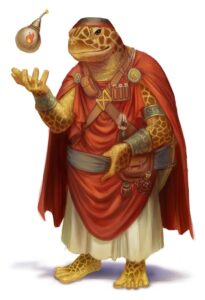
I’ve talked at length about my love for Eddie Webb’s Pugmire and its sister book Monarchies of Mau on this website. Well, just a few short months ago – or was it an eternity? Time feels weird and meaningless now – I received my hard copy of the third book within this line, Pirates of Pugmire
Instead of being a full rulebook like either Pugmire or Monarchies of Mau, this book is a sourcebook that adds additional material to the existing games along with new material to tell a tale about living the thrilling life of a sailor on the Acid Sea, exploring strange new lands and pursuing rumors of long forgotten treasures.
Chapter one is actually a short story set in the world that introduces you to the NPC “guides” that speak to the reader in the sidebars. It’s short, entertaining, and fills it’s purpose of giving you a brief look into the setting.

Chapter two then gets into the meat of the new material by introducing two new species that players can choose the pirates’ life for – lizards and birds, each with three options. Lizards can be of the gecko, serpent, or turtle families and birds can be of parrot, crow, or sparrow “neste.” This choice determines what attributes get bonuses as well as a starting ability for them.
This chapter also introduces six new “callings” (the game’s term for class) into the mix that players can choose from. Two of them – the paladin-like Crusader and the firearm wielding Gundog require the use of the Pugmire Rulebook while two more – the stealthy yet firearm trained Torpedo and the spellcasting Mystic require the use of the Monarchies of Mau book. The last two are the potion-slinging Alkalist and the bombastic performers known as the Rimers. While these last two are aimed at lizards and birds respectively, each of the other four callings has sidebars on why these two species might pursue those callings as well. Dogs and cats, however, cannot be Alkalists or Rimers per rules as written and can only select from Crusader and Gundog or Torpedo and Mystic respectively.

Chapter three introduces how ships work, both from a mechanical standpoint as well as the day to day life and expectations of sailors on those ships. There’s honestly not a lot of material here for something that is so central to the game. The chapter only clocks in at ten pages and two of those introduce a handful of new spells.
Chapter four talks about why pirates from each species might exist and take to the Acid Sea and introduces two of the largest port cities in the Kingdom of Pugmire and the Monarchies of Mau – Waterdog Port and Port Matthew, giving a high level overview of both places as well as some possible adventure hooks. Again, for something that feels so central to the book, I’m a little bit disappointed that this chapter is also so short.
Chapter five introduces a handful of new enemies while chapter six introduces the concept of “treasures” – unique items that grant special effects and grant your pirate notoriety. But these treasures may also carry unique drawbacks or even be cursed. And chapter seven introduces a handful of notable locations that exist outside of the Kingdom or the Monarchies that pirates and other sailors may frequent as well as a basic map.
And finally, the book ends with three adventures that are meant to be played in order to form a short Chronicle, though each of them can be played as a self-contained adventure in and of itself. The adventures themselves are solid, using concepts that are introduced earlier in the book such as ships and ship combat but they take up a full quarter of the book’s page count. Personally, I would have preferred a few more adventures released as a separate book and instead use the page count to expand other chapters that could use more rules, more clarification, or simply more information altogether. There are a number of sections where there just doesn’t feel like there’s enough information or there are important details being omitted.
Like the other releases in this line, the production values are great. The art is gorgeous and brings the setting to life in a way that is both compelling and whimsical, something that I have always enjoyed about these releases. All in all, I think it’s a competent addition to the line, though I feel that it falls a little bit short in actual content offered. For the price, I can’t say that it’s worth grabbing unless the concept really speaks to you and even then – be ready to invent some stuff that the book really doesn’t cover in much detail.
